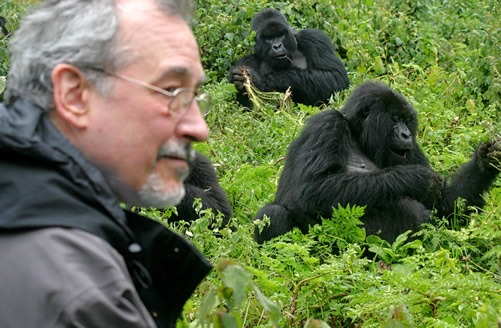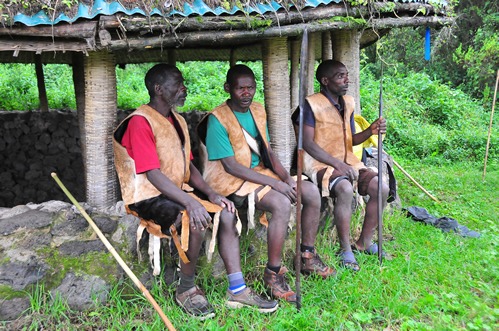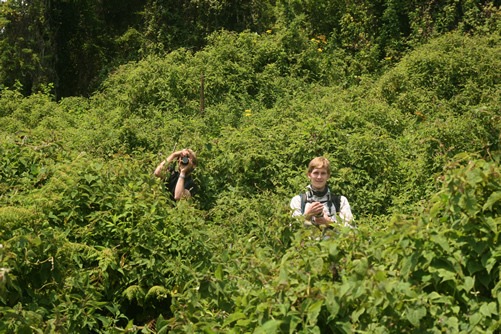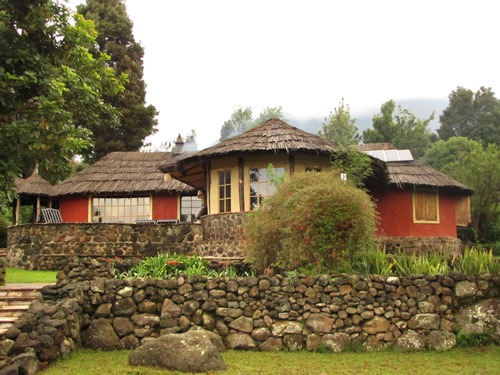Gorilla Trekking in Mgahinga may not be as popular as in Bwindi forest but Mgahinga has and interesting gorilla group and other advantages that we will discuss shortly. The park is located in southwestern Uganda – near Uganda’s border with Rwanda and the Democratic Republic of Congo. It has a total surface area of 33.9km², making it the smallest national park in Uganda. The Uganda Wildlife ![]() Authority took a step to gazette Mgahinga into a national park in 1991 and the main reason was to protect the critically endangered mountain gorillas.
Authority took a step to gazette Mgahinga into a national park in 1991 and the main reason was to protect the critically endangered mountain gorillas.
Mgahinga is composed of three dormant volcanoes – Mount Gahinga, Muhavura and Sabyinyo. The three volcanoes are covered by four main types of vegetation – Albertine, montane forests, bamboo forests and semi-alpine forests. The mountain ranges in Mgahinga rise at an average altitude of between 7,000 to 13,000 feet making it a perfect environment for mountain gorillas, golden monkeys and countless species of birds. It is also one of the original homes of the Batwa pygmies.
Albeit Mgahinga national park has a number of wildlife species, it is more known for its mountain gorillas. Mgahinga has only one habituated gorilla family called Nyakagezi. Nyakagezi is an area within the park where the primates live and feed for most of the time. The Nyakagezi group lives right on the border territories of Rwanda, Uganda and the Democratic Republic of Congo. They used to cross to the other two countries but the Uganda Wildlife Authority ensures that they remain on the Uganda side. The Nyakagezi family is one of the largest habituated mountain gorilla groups with 4 silverbacks. The group has become a favorite for trackers because they are always available and trekking is less challenging.
Mgahinga National Park is about 490kms away from Kampala (9 hours of driving). The park can be accessed by both road and air. The road journey start from Kampala through Mbarara, Kabale, Kisoro and finally to Mgahinga national park. A traveler can also use a charter flight by Aerolink to either Kisoro Airstrip or Kihihi Airstrip and then embark on the ground transportation to Mgahinga national park. It is advisable to land at Kihihi airstrip since the weather is more conducive for air transport than Kisoro which is sometimes disrupted by too much fog in the atmosphere. The gorilla trekking permits cost the same as that of Bwindi Impenetrable Forest ($700) since the travelers gets the same experience. Only 8 gorilla permits are available in Mgahinga national park since there is only one family to track. You can find out more from our 3 days gorilla trekking in Mgahinga safari package.
Comparing Gorilla Trekking in Mgahinga and Bwindi?
 Uganda is the only country in the world with two mountain gorilla habitats. The primates are found in Mgahinga National park and Bwindi impenetrable National Park. The gorillas look the same in both parks since they are of the same sub-species. The gorilla trekking rules and regulations are the same. The overall cost of gorilla trekking is the same when you factor in accommodation and transport. It also important to mention that the gorilla trekking experience is the same in both national parks. In fact, the chances of seeing gorillas in Uganda is very high (almost 100%) and like we said, the gorilla permits in both parks cost the same. The main differences are: –
Uganda is the only country in the world with two mountain gorilla habitats. The primates are found in Mgahinga National park and Bwindi impenetrable National Park. The gorillas look the same in both parks since they are of the same sub-species. The gorilla trekking rules and regulations are the same. The overall cost of gorilla trekking is the same when you factor in accommodation and transport. It also important to mention that the gorilla trekking experience is the same in both national parks. In fact, the chances of seeing gorillas in Uganda is very high (almost 100%) and like we said, the gorilla permits in both parks cost the same. The main differences are: –
Mgahinga National park is composed of bamboo and montane forests while Bwindi covered with tropical rain forests. However, Mgahinga National Park has less mountain gorillas compared to Bwindi Impenetrable National park. Mgahinga has only one gorilla group whereas Bwindi impenetrable national park has almost half of the total population of the mountain gorillas in the world (about 420 individuals) with 20 habituated groups. This implies that Bwindi gorilla trekking offers more variety.
![]() Bwindi Impenetrable National park has a total surface area of 331km² as opposed to Mgahinga which has a smaller surface area of only 33.9km². Bwindi also has four sectors for tracking gorillas – Buhoma located in the north, Ruhija to the East, Rushaga and Nkuringo located in the south. Mgahinga only has one point for gorilla trekking and that is at Ntebeko.
Bwindi Impenetrable National park has a total surface area of 331km² as opposed to Mgahinga which has a smaller surface area of only 33.9km². Bwindi also has four sectors for tracking gorillas – Buhoma located in the north, Ruhija to the East, Rushaga and Nkuringo located in the south. Mgahinga only has one point for gorilla trekking and that is at Ntebeko.
At Mgahinga National Park, a traveler has a wide range of activities to engage in other than gorilla trekking like the more comprehensive Batwa trail, mountain hiking, nature walks and birding while in Bwindi there are fewer extra activities (birding, nature walks and community walks). Mgahinga is the only park in Uganda where one can track both golden monkeys and gorillas.
What else to do apart from gorilla trekking
Mgahinga may be small but it is not a one activity national park. Apart from mountain gorillas, it has several attractions to offer visitors. Mgahinga has the highest number of the amazing golden monkeys, three scenic volcanoes, opportunities for cultural encounters (the Batwa pygmies), a variety of bird and mammal species to encounter on a nature walk. We will discuss them more in detail: –
![]() Golden Monkey Trekking: Monkeys are liked by everyone due to their playful nature but the golden monkeys add another spark and that is their eye-catching color. They are also very cute and a favorite with tourists. Golden monkeys are subspecies of the blue monkey. Mgahinga national park is one of the few places in the world where one can see the golden monkey. About 5000 call Mgahinga National Park home and to track them, you need to purchase permits at a cost of $60.
Golden Monkey Trekking: Monkeys are liked by everyone due to their playful nature but the golden monkeys add another spark and that is their eye-catching color. They are also very cute and a favorite with tourists. Golden monkeys are subspecies of the blue monkey. Mgahinga national park is one of the few places in the world where one can see the golden monkey. About 5000 call Mgahinga National Park home and to track them, you need to purchase permits at a cost of $60.
Nature Walks: Mgahinga national park is covered with bamboo and montane forests which are home to several wildlife species. As we already know now, you can see gorillas, golden monkeys, forest mammals, unique tree species, birds, flowers and reptiles. A guided trek around the park is always great and very rewarding. The main walking trails are the Sabinyo trail, Mgahinga gorge walk trail and border trail.
The Batwa Trail experience: This Batwa Trail in Mgahinga is one of the most popular cultural experiences in Uganda. The experience takes you to visit the Batwa pygmies – one of the most  marginalized indigenous tribes in Uganda. The Batwa once lived in the forests of Mgahinga, Volcanoes, Bwindi and Virunga National Park. They lived as hunters and gatherers for thousands of years. Unfortunately, most have been driven away from the forests to live in unfamiliar environments where they have to deal with tribal groups they had avoided for years. The Batwa Trail takes visitors to explore the forest and understand the kind of life lived by the Batwa. It is led by the Batwa themselves. The trail ends with a visit of the sacred Garama caves. After visiting the forests, visitors are then entertained through storytelling, traditional dances, drama and music.
marginalized indigenous tribes in Uganda. The Batwa once lived in the forests of Mgahinga, Volcanoes, Bwindi and Virunga National Park. They lived as hunters and gatherers for thousands of years. Unfortunately, most have been driven away from the forests to live in unfamiliar environments where they have to deal with tribal groups they had avoided for years. The Batwa Trail takes visitors to explore the forest and understand the kind of life lived by the Batwa. It is led by the Batwa themselves. The trail ends with a visit of the sacred Garama caves. After visiting the forests, visitors are then entertained through storytelling, traditional dances, drama and music.
Cave exploration: Mgahinga National Park has numerous caves that used to be home to the Batwa people. An extensive exploration of the caves in Garamba and Muhavura is very rewarding. By exploring the caves, one can learn more about the ways of the Batwa people. These mysterious caves are very long and filled with bats.
Mountain Climbing in Mgahinga: The three volcanoes within Mgahinga national park offer one-day hiking experiences that are very challenging. Mount Muhavura is the most popular volcano. At 4,100 ![]() meters high, it is the tallest of all the three volcanoes. It is a steep mountain and it is recommended that hikers get a hiking stick and boots while climbing it. At the summit, hikers have a great view of the other Virunga volcanoes, the Bwindi Impenetrable forest and the mountains of the moon. Mount Sabinyo on the other hand is shared by Uganda, Rwanda and Congo. It is 13,540 feet tall and while at its peak, you can step in the borders of three countries. Climbing up and down Mount Sabinyo takes about 8 hours. Mount Gahinga is the shortest of the three volcanoes within Mgahinga national park. It stands at a height of 3,474 meters above sea level and it only takes seven hours to conquer it.
meters high, it is the tallest of all the three volcanoes. It is a steep mountain and it is recommended that hikers get a hiking stick and boots while climbing it. At the summit, hikers have a great view of the other Virunga volcanoes, the Bwindi Impenetrable forest and the mountains of the moon. Mount Sabinyo on the other hand is shared by Uganda, Rwanda and Congo. It is 13,540 feet tall and while at its peak, you can step in the borders of three countries. Climbing up and down Mount Sabinyo takes about 8 hours. Mount Gahinga is the shortest of the three volcanoes within Mgahinga national park. It stands at a height of 3,474 meters above sea level and it only takes seven hours to conquer it.
 Birding in Mgahinga: Mgahinga National Park is a bird haven with over 76 bird species. The best birding spots in Mgahinga national park are on the slopes of mount Gahinga and Sabinyo. Birds love the montane and bamboo forests thriving on the slopes of these mountains. Some of the bird species to watch out for in Mgahinga National Park include the Rwenzori turaco, handsome francolin, common cuckoo, regal sunbird, fire finch, olive pigeon, woodpeckers, Dusky Turtle Dove, Rwenzori nightjar and the red throated Alethe just to mention a few.
Birding in Mgahinga: Mgahinga National Park is a bird haven with over 76 bird species. The best birding spots in Mgahinga national park are on the slopes of mount Gahinga and Sabinyo. Birds love the montane and bamboo forests thriving on the slopes of these mountains. Some of the bird species to watch out for in Mgahinga National Park include the Rwenzori turaco, handsome francolin, common cuckoo, regal sunbird, fire finch, olive pigeon, woodpeckers, Dusky Turtle Dove, Rwenzori nightjar and the red throated Alethe just to mention a few.
Accommodation during Gorilla Trekking in Mgahinga
Accommodation facilities around Mgahinga national park are differentiated by the quality of services and rates they offer clients. They are into three categories – budget, mid-range and luxury lodges. We will describe them in brief below: –
![]() Mount Gahinga Safari lodge: This is a luxury facility with high-end services but built with local materials. The lodge is built at the base of the three mountains and very close to the park offices.
Mount Gahinga Safari lodge: This is a luxury facility with high-end services but built with local materials. The lodge is built at the base of the three mountains and very close to the park offices.
Amajambere Iwacu camp: Those who are interested in basic accommodation should consider this lodge. It is built close to the park offices and has very comfortable self-contained facilities with a restaurant serving excellent food. The camp also has dormitories for large groups and students.
Chameleon Hill Lodge: This is a high-end lodge with very good looking structures. It is built on a hill near Lake Mutanda. From the lodge premises, guests can get amazing views of the tropical rain-forests and the Lake.
Traveler’s rest Hotel: This is a mid-range lodge with 12 self-contained rooms. The lodge is located in Kisoro town and was the first accommodation facility in the area.
 Nkuringo Safari Lodge: Nkuringo lodge is located within Bwindi Impenetrable national park (Nkuringo sector) but very close to Mgahinga national park. The luxury lodge offers executive cottages for tourists who are interested in the ultimate comfort while exploring the park.
Nkuringo Safari Lodge: Nkuringo lodge is located within Bwindi Impenetrable national park (Nkuringo sector) but very close to Mgahinga national park. The luxury lodge offers executive cottages for tourists who are interested in the ultimate comfort while exploring the park.
Clouds Mountain Gorilla Lodge: This is another high end lodge located within the vicinity of Bwindi Impenetrable National park but easily connects to Mgahinga national park. Everything about the lodge is high-end. The services are delivered with high quality but at a price.
Mount Gahinga Rest Camp: This is the nearest budget lodge to the Mgahinga National park head offices in Ntebeko. It has basic rooms with grass thatch roofs and also some good camping tents.
Mount Gahinga Lodge: This is another luxury lodge nestled at the basement of the three volcanoes. It was set up in 1997 to serve as a place to stay for guests who were booked for gorilla trekking, golden monkey tracking and visiting the Batwa pygmies. The lodges have everything one would expect in a high quality luxury lodge.


